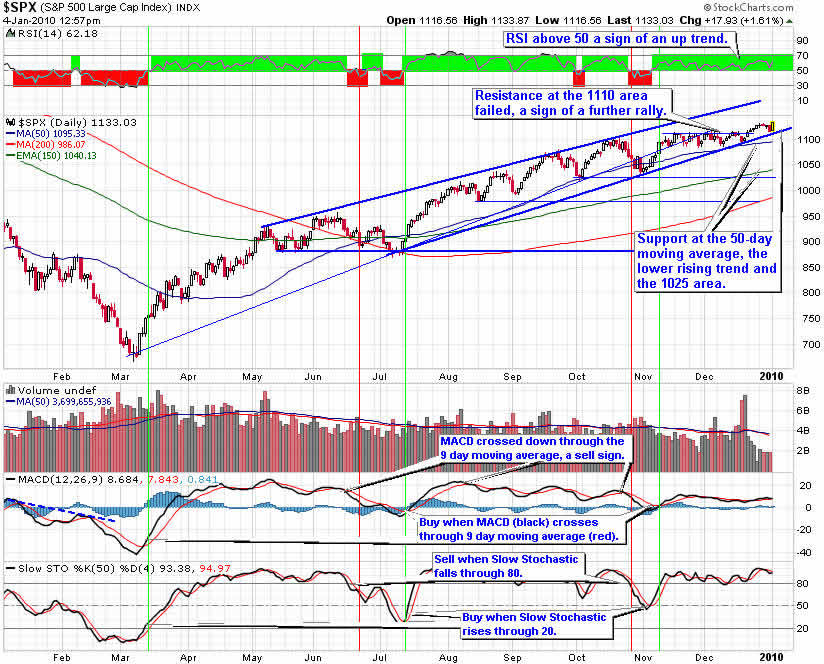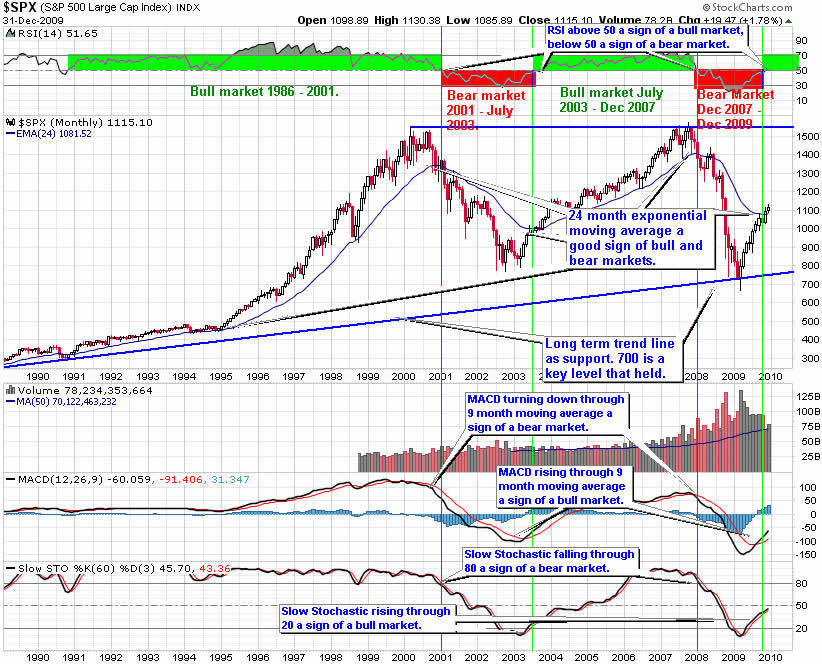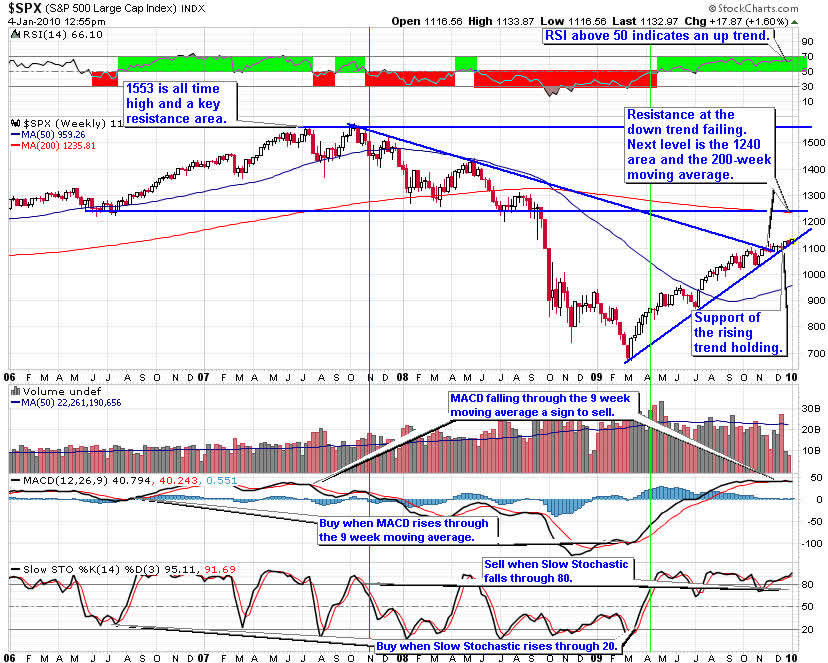S&P 500 Stock Market Trends Forecast for January 2010
Stock-Markets / Stock Markets 2010 Jan 06, 2010 - 02:12 AM GMTBy: Hans_Wagner
 This is monthly chart for the S&P 500 showing 20 years of performance. Since this index is the one used by professional traders, it is important to understand how it is performing. This chart is also excellent at defining the longer term trends for the market.
This is monthly chart for the S&P 500 showing 20 years of performance. Since this index is the one used by professional traders, it is important to understand how it is performing. This chart is also excellent at defining the longer term trends for the market.
The bull market of the last five years broke down when the S&P 500 turned down through the 24-month exponential moving average. The bear market began when the index fell through the 24-month exponential moving average. Also, the RSI tested the 50 level, another important indicator of bear markets (if the RSI remains below 50 then we are in a bear market) and turned back down. The MACD crossing down through zero is another sign of the transition from bear market to bull market. Finally, the Slow Stochastic fell through 80 as another sign of the beginning of the bear market.
The rally that began in early March has continued through December. The index closed above the 24-month Exponential Moving Average in November a sign of strength.
The RSI has crossed through 50, the final signal the bear market is over and a sign of an up trend. The Slow Stochastic and the MACD are trending up. Monitor how the Slow Stochastic handles the 50 level when it gets there.
November was the beginning of what is considered the best six months of the year. Therefore, we should expect the market to relatively well.
For now, I intend to invest as though we are in a more normal market that will see rallies and then pull backs. The rally of the last nine months came as a rebound from an oversold condition as investors feared the worse. Going forward, we will experience market rallies and pull backs as the economy struggles to expand. The overall trend will be more sideways.
You can click on the link below to see a current version of this chart.
Big Picture S&P 500
The four-year weekly S&P 500 trend chart shows that the market continues to rise, having broken through resistance of the multi-year down trend. The next resistance level is the 1240 area or the 200-week moving average.
The rising trend has been support since the rally started in March. As long as this support holds, the rally will continue.
RSI is above 50, a sign of an up trend. The MACD continues to rise, though it is reaching a high point where it will eventually turn down, giving a sell signal. The Slow Stochastic fell through 80 giving a sell sign and then rebounded. The next time it falls through 80 it will give another sell signal.
The weekly chart pattern indicates the S&P 500 continues to rally. Monitor support to be sure it holds. If the support at the ascending trend fails, look for the a pull back.
You can click on the link below to see a current version of this chart.
S&P 500 Weekly Chart
A rising channel is the most definitive pattern for the daily S&P 500. This is a bullish formation. Support is the lower rising trend and the 50-day moving average. Resistance is at the upper rising trend.
RSI is above 50 indicating an up trend. The MACD is at a high point where it normally turns down through the 9-day moving average, giving a sell sign. The Slow Stochastic remains above 80 where it will turn down giving a sell sign eventually.
The daily chart of the S&P 500 is telling us the rally is continuing as long as the lower rising trend and 50-day moving average hold as support.
At some point, most likely in the nest couple of months, the rising trend will fail and the market will pull back. this will be the signal that the rally has ended and the market is transitioning into a sideways trending pattern. Highs will be in the 1250 area and lows in the 1000 level.
This will cause us to change our strategy going forward. Selecting the right sectors and stock picking will become more important to your success. Look to buy on dips in the market to important support levels. Then add down side protection at interim high points using trailing stops and protective put options to help improve the overall return. Covered calls options will also work well when the market is not rising as rapidly as the last nine months.
S&P 500 Daily Chart

Given this analysis of the S&P 500 trend line charts, it is important to begin to position your portfolio for a market that is more likely to trend in a range with cyclical rallies and pull backs.
The charts of the S&P 500 trend lines provide a good way for investors to align their portfolios with the overall market trends. Picking the right sectors and stocks will become even more important. Look to buy on dips in the price of the S&P 500 trend charts on the next pull back. Be sure to use proper capital management techniques including trailing stops, protective put, covered call options and position sizing. When the pull back ends, look to add to long positions with stocks and ETFs from the sectors that are likely to outperform the overall market. Keep in mind, Warren Buffett's first rule of investing is to not lose money. Be patient waiting for good entry points.
If you wish to learn more on evaluating the market cycles, I suggest you read:
Ahead of the Curve: A Commonsense Guide to Forecasting Business and Market Cycles by Joe Ellis is an excellent book on how to predict macro moves of the market.
Unexpected Returns: Understanding Secular Stock Market Cycles by Ed Easterling. One of the best, easy-to-read, study of stock market cycles of which I know.
The Disciplined Trader: Developing Winning Attitudes by Mark Douglas. Controlling ones attitudes and emotions are crucial if you are to be a successful trader.
By Hans Wagner
tradingonlinemarkets.com
My Name is Hans Wagner and as a long time investor, I was fortunate to retire at 55. I believe you can employ simple investment principles to find and evaluate companies before committing one's hard earned money. Recently, after my children and their friends graduated from college, I found my self helping them to learn about the stock market and investing in stocks. As a result I created a website that provides a growing set of information on many investing topics along with sample portfolios that consistently beat the market at http://www.tradingonlinemarkets.com/
Copyright © 2010 Hans Wagner
Hans Wagner Archive |
© 2005-2022 http://www.MarketOracle.co.uk - The Market Oracle is a FREE Daily Financial Markets Analysis & Forecasting online publication.





